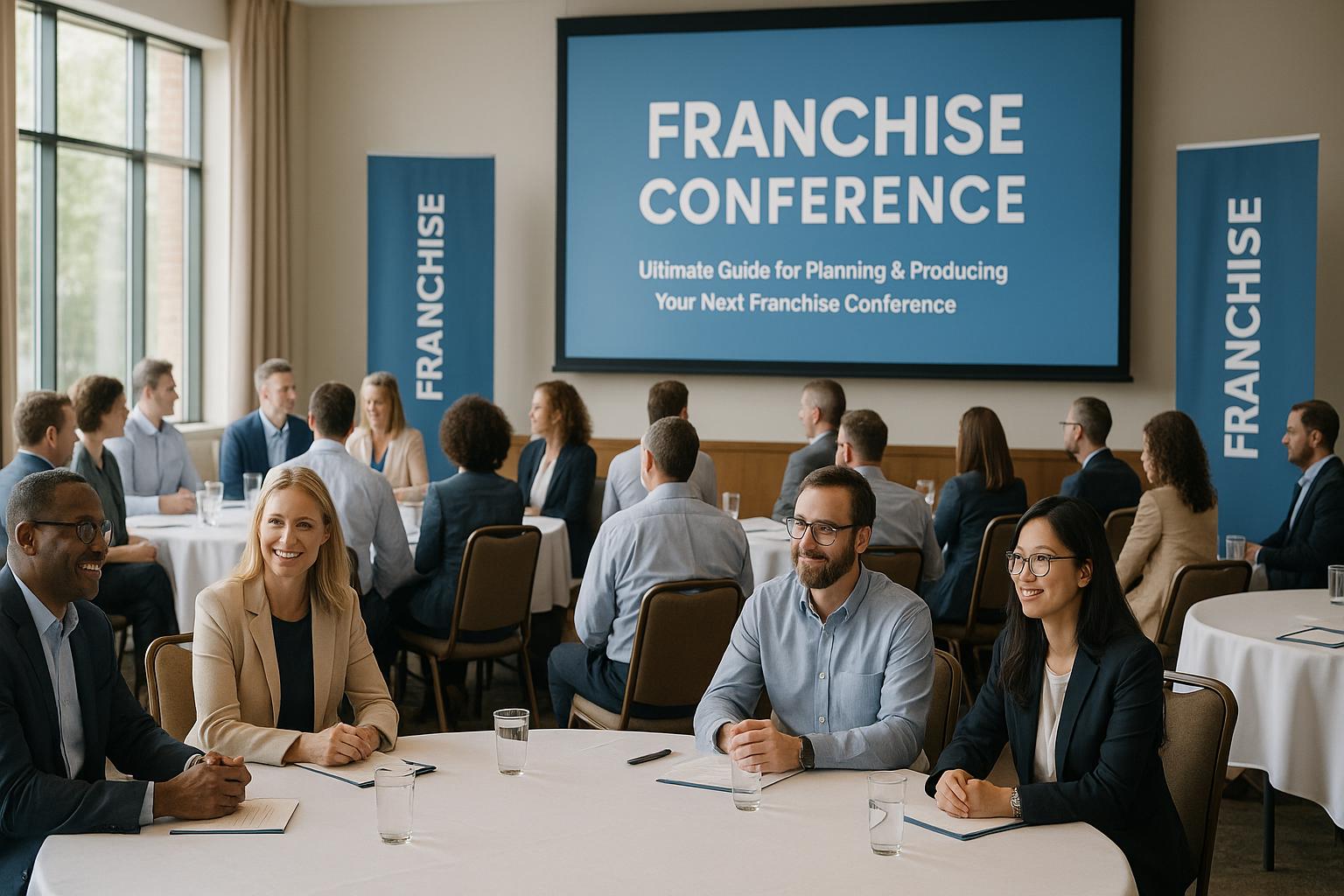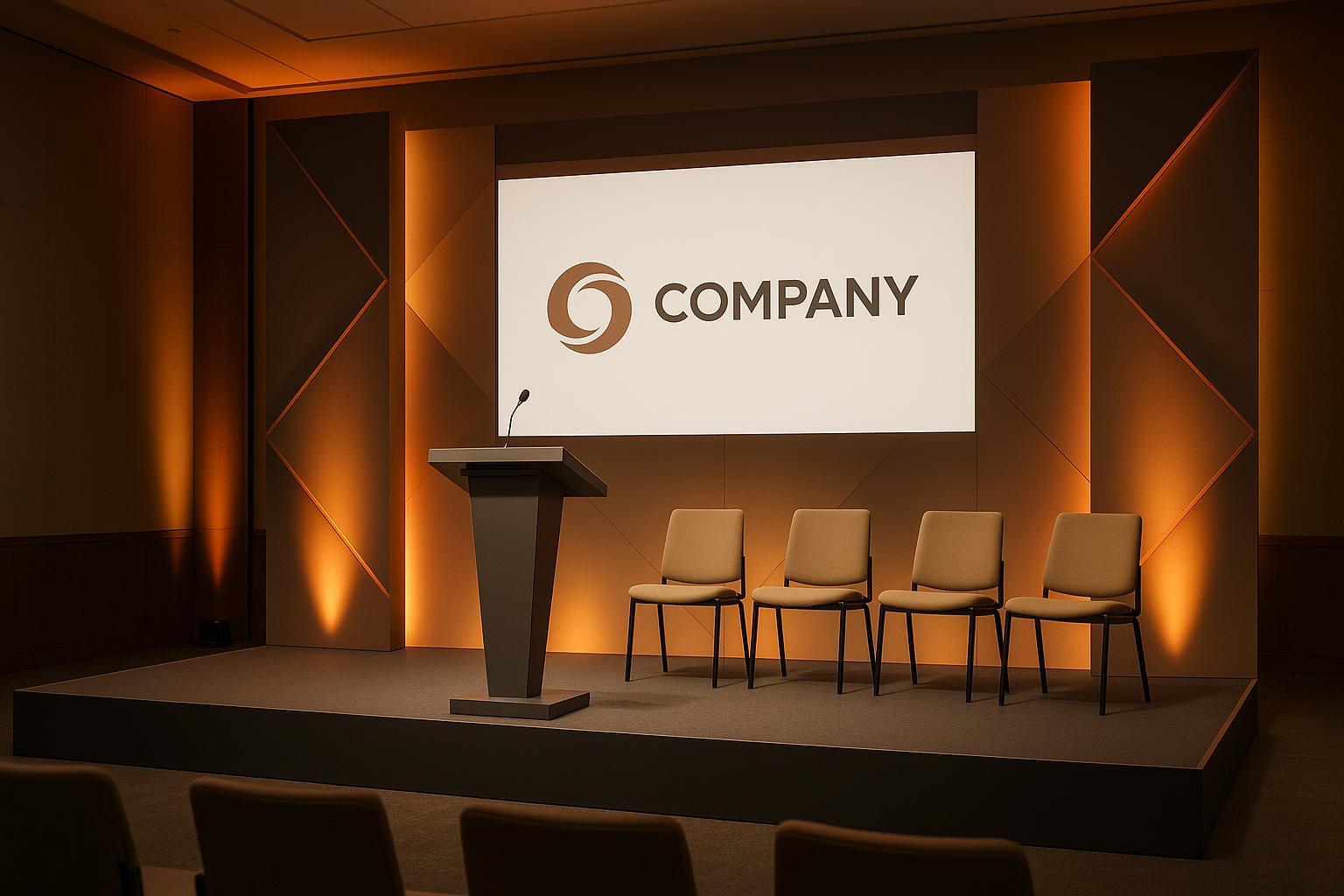Ultimate Guide For planning & Producing Your Next Franchise Conference

Chief Executive Officer

Franchise conferences are essential for aligning franchisors, franchisees, and vendors on strategies, brand standards, and growth opportunities. These events require careful planning to balance corporate goals with franchisee needs. Here's a quick breakdown of what makes a successful franchise conference:
-
Core Goals:
- Reinforce brand standards and share updates.
- Facilitate knowledge sharing and networking.
- Motivate and recognize franchisees' achievements.
- Address franchisee concerns and provide solutions.
-
Stakeholders to Consider:
- Franchisees: Seek practical tools and insights.
- Corporate leadership: Share vision and gather feedback.
- Vendors: Showcase products and build connections.
- Support staff: Strengthen relationships and coordinate initiatives.
-
Key Planning Steps:
- Gather pre-event feedback via surveys and committees.
- Negotiate venue and hotel contracts for cost efficiency.
- Use advanced audiovisual tools like live streaming and interactive apps.
- Form franchisee committees to ensure relevant content.
-
Post-Event Focus:
- Collect attendee feedback and analyze engagement.
- Use data to refine future conferences.
FranCamp Dallas | Franchise Growth Mastermind | March 3-5

Understanding the Goals of a Franchise Conference
Franchise conferences serve as a critical link between corporate strategy and franchisee execution. These gatherings are not your typical corporate meetings; they are tailored to the unique dynamics of franchise systems, where independent business owners must balance their autonomy with the need to adhere to a unified brand vision.
Setting Clear Objectives
The main purpose of a franchise conference is to bring together diverse stakeholders and align them around a shared vision. These events aim to reinforce brand standards, share practical solutions, and celebrate achievements, all while empowering franchisees to excel.
Reinforcing brand guidelines is a top priority. Since franchisees operate independently, variations in how corporate standards are implemented can arise. Conferences provide an opportunity to clarify brand protocols, introduce updates, and emphasize the importance of consistency across all locations.
Another key goal is knowledge sharing. Franchisees often develop innovative ways to tackle common challenges. Conferences create a platform for sharing these best practices across the network, enabling everyone to benefit from collective experience.
Motivation and recognition also play a big role. Franchisees often work in isolation, managing their businesses without regular interaction with peers or corporate leadership. Conferences offer a chance to celebrate accomplishments, honor top performers, and highlight the value of being part of a larger network.
Lastly, corporate leadership can use the event to communicate strategic updates. Whether it's launching new products, revising operational procedures, or discussing market expansion plans, conferences provide a structured environment to share important information and address franchisee concerns directly.
With these goals in mind, it’s essential to tailor the conference experience to meet the unique needs of all stakeholders.
Identifying Stakeholders and Their Needs
Franchise conferences bring together a variety of stakeholders, each with their own expectations and priorities. Understanding these perspectives ensures the event agenda delivers value to everyone while supporting system-wide growth.
Franchisees attend these events looking for practical solutions to their day-to-day challenges, opportunities to network with peers, and clarity on corporate direction. They want actionable insights they can implement immediately. New franchisees may need foundational training, while seasoned operators often prefer advanced sessions on growth strategies or emerging trends.
Corporate leadership sees these conferences as a chance to reinforce company values, share strategic initiatives, and gather feedback from the field. They value opportunities to connect directly with franchisees, address concerns, and demonstrate their commitment to the network’s success. Presentations from executives should balance inspiration with actionable guidance.
Vendor partners and suppliers often participate as sponsors or exhibitors. Their goal is to strengthen relationships with franchisees and showcase new products or services. While their involvement can add value for attendees and help offset event costs, it’s important to ensure their participation aligns with franchisee needs rather than feeling overly sales-driven.
Regional managers and support staff act as the bridge between corporate and franchisees. For them, the conference is a chance to build stronger relationships, gather feedback on support services, and coordinate upcoming initiatives. These team members often lead breakout sessions or provide one-on-one consultations during the event.
It’s also important to consider the financial investment of each group. Franchisees typically cover their own travel and lodging expenses, making their time especially valuable. Corporate teams view the event as a business development tool. Understanding these different cost structures ensures the agenda delivers meaningful value to all participants.
Using Pre-Event Feedback for Agenda Planning
To create an agenda that resonates with attendees, gather pre-event feedback from your franchise network. This step ensures the event addresses real needs rather than relying on assumptions.
Start with digital surveys to collect input from franchisees. These surveys should focus on actionable topics, such as identifying operational challenges, training needs, or preferred learning formats. For example, ask questions like, "What marketing strategies would you like to learn more about?" or "Which operational areas need additional support?"
Regional focus groups can provide deeper insights. These smaller sessions allow franchisees to discuss challenges in detail and propose targeted solutions. Regional managers can facilitate these discussions and pass along key takeaways to the planning committee.
Involving franchisees directly through planning committees ensures ongoing input throughout the process. These committees, made up of representatives from various regions and experience levels, can meet regularly via video calls to review agenda proposals, suggest speakers, and refine session formats.
Don’t overlook past event evaluations as a resource. Feedback from previous conferences often highlights what worked well and what didn’t. Look for patterns in comments about session length, speaker effectiveness, and topic relevance. Suggestions for future topics can also reveal emerging issues or opportunities within the network.
Finally, use feedback to identify preferred learning formats. While some franchisees may favor traditional presentations, others might benefit more from interactive workshops or peer-led discussions. Offering a mix of formats ensures the agenda engages attendees with different learning styles and levels of experience.
Step-by-Step Guide to Event Logistics
Negotiating Venue and Hotel Contracts
When it comes to managing event logistics, negotiating venue and hotel contracts can make a big difference. It helps you cut costs, lock in favorable terms, and build in flexibility for unexpected changes. Start by comparing venues carefully to ensure the space aligns with your event's specific needs. This step sets the stage for organizing the rest of your event checklist effectively.
Incorporating Audiovisual Technology for Impact
When done right, audiovisual technology can take your franchise conference from a routine meeting to an unforgettable experience that leaves a lasting impression. Today’s AV solutions go well beyond the basics of microphones and projectors - they create dynamic, immersive settings that keep audiences engaged and connected from start to finish. Let’s dive into some key AV tools that can elevate your conference.
Key AV Solutions for Franchise Conferences
Professional staging and scenic design lay the groundwork for a standout event. Custom-built stages not only give speakers a platform but also encourage audience interaction. LED video walls ensure every attendee, no matter where they’re seated, can see presentations clearly and stay tuned in.
Live streaming capabilities have become a must, especially for franchises with teams spread across multiple time zones. With a professional setup, you can use multiple strategically placed cameras to capture speakers, audience reactions, and presentation materials all at once. To avoid buffering or interruptions, it’s crucial to have strong bandwidth and high-resolution streaming.
Hybrid event technology bridges the gap between in-person and remote participants. Features like interactive polling systems let everyone - whether in the room or online - participate in Q&A sessions. Breakout room features also enable smaller group discussions, fostering collaboration. Professional hybrid setups often include specialized lighting to ensure remote viewers get a clear view of speakers and visuals.
Advanced sound reinforcement ensures every word is heard with clarity. Wireless microphones with multiple channels make it easy to manage panel discussions and audience participation. Behind the scenes, sound engineers work to keep audio levels consistent throughout the event.
Role of Corporate Optics in AV Production
Corporate Optics takes these technologies a step further, offering full-service AV production that covers everything from stage design to post-event analytics.
Their custom fabrication capabilities create event spaces that reflect your franchise’s identity. This might include branded registration desks, backdrop walls, or interactive displays that highlight franchise achievements and initiatives. Every detail is designed with your conference goals in mind, ensuring a polished and cohesive look.
Speaker support services are another key offering. This includes technical rehearsals, microphone fittings, and live presentation assistance. Their team handles sound checks and lighting adjustments for every speaker, so franchise leaders can focus on delivering impactful messages without worrying about technical hiccups.
For live streaming production, Corporate Optics offers multi-camera direction, real-time graphics integration, and professional audio mixing. They can stream your event across multiple platforms simultaneously, making it easy for franchisees who can’t attend in person to join. Recordings from these sessions also become valuable training tools for future use.
Post-event analytics are a game changer. They provide detailed data on attendee engagement, session popularity, and content effectiveness. This insight helps franchises understand what resonated with their audience and identify areas for improvement in future events.
Engaging Your Audience with Technology
Planning a successful conference doesn’t stop with logistics - engaging technology is key to keeping your audience actively involved. Tools like mobile apps, AI-driven systems, and real-time feedback mechanisms can transform attendees from passive listeners into active participants.
Interactive mobile apps make engagement easy. These apps often include features like live polling, session ratings, and networking tools that connect franchisees dealing with similar challenges. Push notifications ensure everyone stays informed about schedule updates and announcements without disrupting the flow of the event.
AI-powered engagement tools take things up a notch by analyzing audience behavior in real time. Speakers can use this feedback to make on-the-spot adjustments, keeping energy levels high. Corporate Optics collaborates with prompts.ai, an AI platform that streamlines corporate event production, bringing cutting-edge tech to franchise conferences.
Real-time feedback collection allows organizers to adapt on the go. Digital tools let attendees rate sessions, suggest future topics, and provide immediate input on franchise initiatives. This feedback loop helps fine-tune the event as it unfolds, addressing concerns before they escalate.
Gamification elements add a fun, competitive edge. Point-based systems reward attendees for participating in sessions, networking, and other activities. Displaying leaderboards on conference screens encourages friendly competition and keeps energy levels high throughout.
To make the most of these technologies, careful planning and expert execution are essential. Partnering with experienced AV production teams ensures your event runs smoothly, allowing you to focus on achieving your business goals and strengthening relationships within your franchise network.
sbb-itb-ae35a94
Managing Stakeholder Collaboration and Coordination
Bringing together internal teams, franchisees, and leadership is key to hosting an event that resonates with your entire franchise network. When everyone works in sync, the quality of the event improves, and engagement across the network increases. A great way to achieve this is by forming a dedicated committee to handle the finer details of planning.
Strong collaboration among stakeholders is the backbone of successful conference planning. It ensures that logistics, AV setups, and session programming stay on track and meet the needs of the network.
Forming a Franchisee Planning Committee
A franchisee planning committee offers valuable, real-world insights into what your network truly needs and wants.
Choosing the right members for this committee is essential. Aim for a mix of franchisees who are actively involved with your brand and represent a variety of perspectives. This could include newer franchisees, experienced operators, top performers, or those tackling unique challenges. Such diversity ensures the committee reflects the broader network’s priorities and concerns.
But this committee isn’t just for gathering feedback. It also serves as a group of internal advocates, energizing and uniting the network. By involving committee members in shaping the event’s agenda - such as identifying key topics for deep dives or recommending franchisee speakers - you can create programming that feels more relevant and impactful. Their input can even influence the event’s physical setup, from staging to scenic design, ensuring the environment encourages meaningful connections.
Including committee members as speakers adds a layer of authenticity to your sessions. Franchisees often relate better to peers who understand their daily challenges. Peer-led roundtables, breakout sessions, or panel discussions can be incredibly effective. You might also consider starting a mentorship program, pairing experienced franchisees with newer attendees to help foster connections and share knowledge within your network.
Best Practices for Communication and Check-Ins
Once your committee is established, regular communication keeps everyone aligned and ensures their input is fully integrated into the event planning process. Schedule consistent meetings, especially during the early stages of planning, to keep momentum strong.
Follow-up surveys can help fine-tune session topics, identify preferred formats, and even highlight potential speakers. Sharing these survey results with the committee helps prioritize what matters most and ensures the final agenda reflects the network’s needs. This ongoing communication also supports the smooth execution of logistics and AV strategies already in place.
The most successful franchise conferences are built on collaboration. By creating structured opportunities for input and maintaining open lines of communication, you can ensure your event is thoughtfully designed to meet the needs of your franchise network.
Post-Event Analysis and Continuous Improvement
Post-event analysis is the key to turning your conference investment into lasting value. While meticulous planning and advanced AV solutions can elevate your event, it's the follow-up evaluation that ensures each conference builds on the last. By capturing feedback and analyzing data, you can transform attendee experiences into actionable insights for future success.
Gathering and Analyzing Feedback
To get a full picture of your event's impact, gather feedback through multiple channels. Digital surveys sent shortly after the event often result in higher response rates, as the experience is still fresh in attendees' minds.
Start with measurable data. For instance, if attendance varies significantly between main sessions and breakout tracks, it may point to scheduling conflicts or a mismatch in content appeal. Monitor engagement during interactive segments and track social media activity to see what resonated most with your audience.
Using tools like Net Promoter Score (NPS) can also provide a snapshot of overall satisfaction. By asking attendees how likely they are to recommend the conference on a scale of 0 to 10, you can gauge general sentiment. High scores indicate strong satisfaction, while lower scores highlight areas needing attention.
Don’t stop at numbers - open-ended questions can uncover valuable insights about session relevance, networking opportunities, and areas for improvement. Real-time tools like mobile apps or live polling can also capture immediate reactions, providing context while the event is still top of mind.
These data points set the stage for deeper analysis and more informed decision-making moving forward.
Using Corporate Optics for Post-Event Analytics
Corporate Optics provides a robust platform for turning raw event data into actionable insights. From audience engagement to AV performance, their analytics cover every aspect of your conference.
The platform tracks how attendees engage with your content, measuring attention during presentations and participation in interactive segments. On the technical side, it evaluates the performance of your audiovisual setup, including audio clarity, visual quality, and streaming reliability for remote participants. Operational metrics, such as registration flow and session transitions, are also collected to identify any logistical challenges.
One of the platform’s strengths is its ability to compare your event’s performance to previous conferences, industry benchmarks, or franchise standards. This comparative analysis helps pinpoint areas for improvement, whether it’s refining your agenda, optimizing your budget, or enhancing specific elements of the event.
Using KPI Comparisons for Future Planning
Feedback and analytics come together when you compare key performance indicators (KPIs) across multiple events. This process reveals trends and helps you identify opportunities for growth. Organizing these metrics into clear summaries makes it easier to spot patterns and make informed decisions.
Track attendance, cost per attendee, sponsorship revenue, and ROI to measure the financial and operational success of your event. For example, if satisfaction scores rise in tandem with increased investments in certain areas, it validates those efforts for future planning.
Content effectiveness is another critical metric. Identifying which session formats consistently engage your audience can guide adjustments to your programming. Similarly, shifts in attendance based on venue changes can highlight the importance of location accessibility in your planning process.
Conclusion: Key Takeaways for a Successful Franchise Conference
Crafting a successful franchise conference starts with a thoughtful, well-rounded strategy that brings all stakeholders on the same page from the very beginning. It’s about blending smart planning, seamless logistics, and meaningful engagement to create an event that delivers real value.
Efficient logistics are the backbone of any great conference. Detailed checklists, realistic budgeting, and savvy venue negotiations can save a significant amount of money while ensuring everything runs smoothly. Since attendees often travel from various locations, choosing an accessible venue and coordinating accommodations are essential steps to make the experience hassle-free.
On the tech side, advanced audiovisual (AV) solutions play a big role in keeping attendees engaged. Features like live streaming open the door for remote participation, while tools like interactive polling and digital engagement platforms turn passive listeners into active contributors. When combined with strong teamwork, these technologies can elevate the event’s overall impact.
Collaboration with stakeholders is another critical piece of the puzzle. As highlighted earlier, involving franchisees in planning committees and keeping communication channels open ensures the conference addresses real challenges and avoids misaligned priorities. This proactive approach helps identify and resolve potential issues before they become major obstacles.
The work doesn’t end when the conference wraps up. Post-event analysis is key to turning your efforts into lasting improvements. By collecting attendee feedback, studying engagement metrics, and tracking performance indicators over time, you can create a cycle of continuous improvement that makes each event better than the last.
For those seeking expert guidance, Corporate Optics offers a full suite of services to support every aspect of franchise conference production. From planning and AV production to post-event analytics and engagement tools, they bring the technical know-how and resources to execute conferences seamlessly. Their expertise, combined with cutting-edge AI-driven solutions, ensures your event stays ahead of the curve while preserving the personal touch that’s so vital in franchise relationships.
Ultimately, the best franchise conferences are more than just one-off events - they’re stepping stones in a larger strategy to strengthen relationships, improve communication, and drive growth across the entire franchise network. By applying these principles consistently and partnering with experienced professionals, your next conference can become a powerful tool for achieving long-term success.
FAQs
How can I gather feedback from franchisees before the event to create a conference agenda that meets their needs?
To craft a conference agenda that truly resonates, begin by gathering input from franchisees ahead of time. Distribute surveys with targeted questions to pinpoint their main priorities, challenges, and what they hope to gain from the event. You might also consider assembling a franchisee advisory group to offer continuous feedback and highlight pressing issues. Don’t forget to analyze insights from previous event surveys to spot patterns and identify areas that could be improved. By involving franchisees early in the process, you ensure the agenda reflects their needs and delivers maximum value.
How can audiovisual technology improve engagement for both in-person and virtual attendees at a franchise conference?
Advanced audiovisual (AV) technology is essential for delivering a smooth and captivating experience at franchise conferences, whether attendees are in-person or tuning in remotely. Top-notch projectors, microphones, and digital displays ensure that presentations are clear and impactful, helping to maintain focus and connection throughout the event.
For virtual participants, tools like video conferencing and real-time content sharing bridge the gap, making remote attendees feel just as involved. Adding interactive elements - like live polls or Q&A sessions - can take engagement to the next level, ensuring that everyone, no matter where they are, feels actively included in the conversation.
How can I ensure the needs of franchisees, corporate leaders, and vendors are met when planning a franchise conference?
To make your franchise conference a success for everyone involved, start by making sure the event reflects your brand’s values and identity. This helps create a consistent, engaging experience that feels true to your organization. Plan sessions that cater to franchisees with different levels of experience and offer a variety of topics to match their diverse interests.
Set aside time specifically for networking, so franchisees can connect, exchange ideas, and build meaningful relationships. Get franchisees involved early by forming a planning committee to bring their perspectives to the table, and gather input from attendees to shape the agenda in a way that meets their needs.
Don’t forget about vendors - give them opportunities to engage with franchisees and provide training sessions. It’s also important to make leadership accessible outside of the main sessions to build trust and show authenticity. After the event, collect feedback to fine-tune future conferences and ensure you’re meeting the expectations of all stakeholders.
Related Blog Posts








